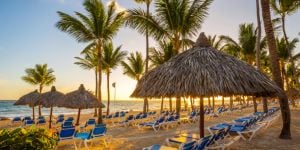Sargassum Seaweed
Last activity 13 August 2019 by alanindr
2713 Views
26 replies
Subscribe to the topic
Post new topic
Last year was a terrible, and perhaps the worst year for Sargassum seaweed throughout all the Caribbean.
On my flights down to the Leeward Islands via Puerto Rico two weeks ago I noticed large lines of the seaweed everywhere again in the seas.
So this article today in Diario Libre about Boca Chica being clogged up with the seaweed was not all together suprising, but the sheer amount in the photo near the marina did shock me.
https://www.diariolibre.com/actualidad/ … JN12799451
Perhaps another bad year is in stall?
Just dreaming...but wouldn’t it be awesome if all countries in Caribbean paid something to a company that created floating biofuel factories and then those countries would get the fuel at cost too. And while I’m dreaming, plastic bags and packaging made from coconut husks, sugarcane scraps, avocado pits ( <– which they already do in Mexico)...at some point sargassum will impact tourism permanently. I read a report that the agricultural run off from Mississippi and Amazon contribute to sargassum...not going to get better anytime soon.
Do Sousa and Cabarete beach get a lot of it?? Punta Cana had some in December when I was there, but I always remember them having to clean it up daily. I think Barbados is one if the worst spots.
I live in a 3rd floor beachfront condo overlooking Sosua Bay, never seen any seaweed here.
Another fine article from David Jessop from another DR publication:
Sargassum: a continuing challenge
It was not to be. A ‘Sargassum Summit’ to develop a multinational response to the worsening problem of the sargassum seaweed washing up on some of the best beaches in the Caribbean, has had to be postponed.
The conference in Cancun, which has been delayed for domestic political reasons, is now expected to take place at a later date. Then Mexico’s Ministry of Foreign Affairs will bring together representatives from government, the private sector, and experts from the Caribbean, Central America and the US to discuss how best to respond to the effect that the environmental phenomena is having on tourism and fisheries, and its damaging economic consequences.
Sargassum, of course, is a type of abundant seaweed creating ocean rafts that stretch for miles. Although ecologically important and a floating habitat for multiple forms of marine life, when carried onshore by prevailing tides and winds it builds up in the form of a rotting mass of foul-smelling vegetation.
In the past it was largely believed to originate in the Sargasso Sea in the West Atlantic. More recently however, scientists believe that it has started to arrive in the Caribbean from the equatorial waters between Brazil and West Africa, where sea temperatures are rising as a result of climate change, and where pesticide and fertiliser runoff from the Amazon and Congo rivers is causing it to proliferate.
So serious has the problem become that a recent MIT Technology Review suggested that the cumulative effect is beginning to disrupt the equilibrium of coastal ecosystems and by killing off the seagrasses that help keep sand in place, is causing beaches to erode more rapidly.
There are indications that the Caribbean may again see this year unusually large amounts of sargassum seaweed washed up on its shores. In recent days large quantities have begun to arrive on Mexico’s south eastern Caribbean coast, with forecasters suggesting that as the year goes on the rest of the region may also suffer.
According to a report produced by the University of South Florida Optical Oceanography Lab, its satellite ocean mapping showed in April large amounts of sargassum across much of the Caribbean Sea except in the nearshore waters of Venezuela and Columbia, and in quantities higher than the historical record set in 2018 for the same month.
Its analysis suggested that this could mean that while ‘the exact sargassum amount, timing, and location of the beaching will depend on local ocean circulations and winds’ the volume in the Caribbean Sea in May-June 2019 may be ‘comparable to or even higher than in May-June 2018, a historical record’.
Although sargassum has been arriving in the Caribbean for many years, its mass has now become so great that voluntary efforts to clean beaches are proving ineffective, with potentially longer term negative economic consequences for tourism in particular.
Tourism Ministers and industry representatives indicate they have become increasingly concerned about the seaweed’s unsightly appearance, visitor complaints, the cost of mechanical removal, and the possibility of reputational damage. There is also some anecdotal evidence of investors questioning the long-term cost implications in relation to projects they are engaged in.
To try to address the issue, the University of the West Indies and a number of other regional and international bodies have been exploring possible solutions including industrial or nutritional uses for the seaweed if processed, issues related to the ecological damage to beaches caused by the use of heavy machinery to clear the sargassum, and what if any technical solutions there may be to keep the seaweed offshore.
One suggestion is that the seaweed should be harvested. A United Nations Environment Programme (UNEP) white paper published in October 2018 indicated a variety of uses including as fertiliser, as an input for nutraceuticals, or for biomass, biogas or other purposes.
Although some enterprises have begun to take advantage of sargassum in this way, for example in St Lucia for fertiliser, sustainability paradoxically is an issue, as there is no guarantee that the seaweed will always be available onshore in the required quantities.
An alternative but costly defensive solution being considered by several countries in the region is the installation of barriers. These, it is suggested, might keep the seaweed from reaching the shore in a manner that will result in the ocean currents then carrying the sargassum back out to sea.
In addition, the Caribbean Regional Fisheries Mechanism announced earlier this year that that it had begun a fact-finding study and why in some years such as 2018 it had reached unprecedented levels with an estimated clean-up cost of US$120m. The survey, funded by the Japan International Cooperation Agency, is expected to suggest actions for the regions fisheries and tourism industry and the scope of support that Japan may provide to help address the problem.
UNEP suggests that the science that causes the annual fluctuation in Sargassum blooms is not well understood and that what is now required is multilateral and multiagency collaboration. It has also proposed a regional early warning system; a remote sensing and ship-based monitoring protocol to report sargassum; greater awareness of the link to climate change; the need for a regional response plan and research agenda; and a greater focus on possible uses: all of which will necessitate new resources.
If the problem of sargassum does occur again this year in the same way as it did in 2018 it will also require clear and sustained visitor messaging by the industry and governments, indicating that such inundations are sporadic, do not affect all beaches and there is much more for a visitor to do.
As the oceans warm, the Sargassum problem may well become more severe, suggesting that a regional technical response will be required and an understanding of who will meet the likely cost of clean-up operations and the development of longer-term responses. Above all, and as the delayed Cancun conference agenda suggests, what is now essential is joined-up approach to yet another environmental issue that has long term economic and ecological implications for the whole region.
David Jessop is a consultant to the Caribbean Council and can be contacted at
david.jessop@caribbean-council.org
Previous columns can be found at https://www.caribbean-council.org/research-analysis/
Recently we saw the problem in Boca Chica and for those driving along Autovia del Este would have seen loads of the seaweed at sea offshre along the stretch to San Pedro to Macoris.
As far as using the seeweed commercially there is now an operating biofuel power station in San Pedro. They are using the sugar cane material which can be seen stockpiled at the plant.
http://www.grupocobra.com/en/proyecto/s … asa-plant/
Article in Diario Libre today.
https://www.diariolibre.com/actualidad/ … GK12900666
It would appear 2019 could be as bad as last year according to University of South Florida.
Great graphic.
Hope the English translator works - it doesn't and you will have to translate using google chrome right click and translate.
grrrr...Where there's a will, there's a way...unless it requires multinational cooperation.
The seaweed problem gest worse!
Today the two electrical generating plants in Haina (Itabo 1 and 2) were shut down for periods due to sargassum seaweed clogging the colling water intakes.
https://dominicantoday.com/dr/economy/2 … wer-plant/
At a time when other power plants are non operational and Punta Catalina is not producing power, this only makes the electrical supply situation in the country insufficient still.
Lucky you expats in Punta Cana and Bayahibe, even Las Terrenas and Las Galeras with your own generator companies or plants. In Santo Domingo even on 24/7 circuits we have had some cuts.
Good news on the power supply is that we have more green energy coming online with a wind farm in Monte Cristi (added to the one recently added in Peravia, near Bani) and a solar farm in Azua coming. And the mini hydro plants in San Juan are proving effective.
In some ways the problem can at least be addressed and mitigated though I am not optimistic at all about doing little more that treating the symptons. The 'disease' is that essentially ALL of the sewerage in the DR is untreated with the prevailing thought being that it's 'sand filtered' on the way back to the ocean. That may separate out the solids but without aerobic digestion the nutrients and pathogens make their way into the ground water and thence to the ocean. Exhibit A is the growth of algae overtaking near shore reefs.
And that is very said indeed and little political will do I see for a comprehensive solution to the problem.
JR
In general, you will find that all the major towns and cities have sewage treatment plans no different to that which you find in other countries. Some large modern plants have been opened in recent years to improve wastewater management and avoid waste water overlow into storm drainage in times of flood (London as am example still has such systems in the day and age). There is one such huge plant north Arroyo Hondo as an example. Certainly all the hotels have good sewage treatment.
Without doubt some raw sewage does find it's way into the rivers from local communities, but even if you employ a plumber in rural DR he will always tell you how to build your septic tank and they are there in every campo dwelling in some form. Yes the shacks alongside the rivers in Santo Domingo may be lacking and as a rule I would avoid swimming in river waters in or near near cities. The greatest flow of waste into the seas from rivers is garbage and plastics and of course there will be sediment runoff with fertilizers too.
DR is far from being backward in that regard and being in the tropics is forunate that sewage does get degraded by bacteria far more quickly than in a temperate climate.
If you read the reports potsed in this thread about the growth of sargassum, you will find that fertilizers used in agriculture are major factors and it isn't the small nations that bear the responsibility for the large amount of the weed flowing with the trade wids from the central atlantic and affecting those small nations such as DR.
If you think we have it bad, compare how the Mexican resorts of Cancun are suffering:
https://news.sky.com/story/rotting-seaw … s-11750404
At least Punta Cana, North Coast resorts and Bayahibe aren't like this.
I was just in Punta Cana for three days, we avoided the beach. It isn't anywhere near as bad as Cancun or the south coast but we still preferred the pool!
Interesting article from BBC which suggests there is a serious problem now with sargassum for the Caribbean. 20 million tons of it extending 8,850kms.
https://www.bbc.com/news/science-environment-48869100
Just flew back from St Maarten to SDQ and looking down from the turbo prop aircraft I could see the seaweed beginning to pile up on the East Coast near Punta Cana with plenty off shore.
Not nice.
They cleaned piles of it 2 weeks ago in punta Cana and a day layer it was piling up again. It's not good but thank goodness it's not just the DR.
It would make great bio-char, a super beneficial soil amendment. Just rinse the salt off first
Not sure they are capable of doing that in the quantity we are receiving. The land does need it especially where they grow sugar cane.
5,500 mile long belt of Sargassum
https://www.space.com/satellites-spot-l … 190714-sdc
I was on the beach at Guayacanes today and yes there were piles of sargassum on the beach but the water was relatively clear and a short way out very swimmable and ideal.
Didn't get pulled over on way home for re-education on driving after a few cold ones. Phew.
I will be heading to Juan Dolio next weekend and will update the situation there.
How is the Cabarete and Sousa area or even Cabrera? Do these areas get much or any?
Articles to help you in your expat project in Dominican Republic
 Working in the Dominican Republic
Working in the Dominican RepublicIf you are looking for a job in the Dominican Republic (DR), here are some tips and suggestions. Job hunting can ...
 Dating in the Dominican Republic
Dating in the Dominican RepublicJust like anywhere else in the world, people in the Dominican Republic want to find love, their significant other, ...
 The healthcare system in the Dominican Republic
The healthcare system in the Dominican RepublicIf you are moving to the Dominican Republic, one of your primary concerns is likely to be the healthcare system ...
 Education in the Dominican Republic
Education in the Dominican RepublicThis article will cover the Dominican Republic's educational system, including public schools attended by 80% ...
 Setting up a business in the Dominican Republic
Setting up a business in the Dominican RepublicThe Dominican Republic has indeed been attracting foreign investment over the past few decades, with notable ...
 Driving in the Dominican Republic
Driving in the Dominican RepublicWhat is driving like in the Dominican Republic and how do you obtain a driving license? Find out all about it in ...
 Death in the Dominican Republic
Death in the Dominican RepublicWhat customs and procedures are common when dealing with death in the Dominican Republic? Find more about it in ...
 Phones, internet, mail, and television in the Dominican Republic
Phones, internet, mail, and television in the Dominican RepublicIf you are moving to the Dominican Republic, like anywhere else in the world, you will most probably want Internet ...
Find more topics on the Dominican Republic forum



